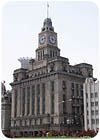
Standing prominently along the Bund with other historical landmarks, the Shanghai Customs House is defined by colonial-area European architecture - a distinctive trait of “Old Shanghai.†The building's striking granite exterior - with large columns, detailed trim work and rough-cut blocks - commands a strong presence on the bustling street of Zhongshan Dong Yi Lu in this heavily traveled Chinese city.
And while the structure that stands today dates back to 1927, its history extends even further. After the Treaty of Nanjing ended the First Opium War in 1842, Shanghai was established as a business center, as the British and other Western nations opened up the city by force and through negotiations. The Bund, which means “embankment,†became the primary shipping, trading and financial district of the area.
The Bund was comprised of mudflats and streams that were drained. Bungalows with spacious verandas served as the first foreign offices. Trade was in silk, tea and opium - all of which Shanghai had a worldwide monopoly on in the late 19th century. This trading ultimately boosted the city's population. Additionally, the benefits of wealth were felt, and it was at this time that many of the landmark buildings in Shanghai were constructed - most in solid stone, adding to the timeless architecture of the Bund. Among these were foreign banks, luxury hotels, private clubs, embassies and the Customs House.
Originally, the Customs House stood in Shanghai between the Huangpu River and the East Gate of the walled city. But due to increased volume of foreign ships, a new structure was built on the Bund to handle the abundance of trade goods. The first Customs House near the walled city was destroyed twice; once in 1853 during the uprisings of the Small Swords Society, and the other in 1860 by the Taiping Rebellions - a nationwide peasant movement.
Under the direction of Customs Inspector General Robert Hart, a British National who was born in Northern Ireland, yet another incarnation of the Customs House was torn down in 1891. It had become old and no longer adequate for its increased functions. The new one, which was built in Western style, was demolished in 1925. Two years later, the building that stands today was constructed.
The new structure, designed by Gong He Foreign Co., is a rendition of Greek Neoclassic style. Most noteworthy of the building's stone architecture is its 10-story clock tower. Considered to be the largest clock in Asia at the time, the structure was made in Britain and modeled after the style of Big Ben. The bell tower, which was actually part of the original Customs House built in 1843, serves as the vertical axis of the building.
Standing at the front entrance to the building are four massive granite columns. These large architectural elements, with their scroll-like ornamentation on the capitals, add to the Greek-style Ionic architecture of the Customs House.
In addition to the columns and bell tower, granite was extensively used for the building's entire exterior facade. The stone was used in both smooth and rock-faced finishes. The textured stone was detailed with deep recesses running horizontally, giving the stonework a sense of strength and permanence. The rock-faced stone can be found at the base of the building, anchoring it to the street and giving it a strong presence among the pedestrians continually passing by. Rock-faced stone also surrounds some of the feature entranceways, where it is also stacked vertically to form arches over the doors.
Contrasting the rough feel of the rock-pitched stone, intricately detailed friezes were also carved from granite to add to the building's dramatic appearance. These elements appear on multiple levels of the exterior. Rich woodwork and detailed ironwork complement the aesthetic of the stone.
Today, the Shanghai Customs House is registered on the list of historic sites. However, even though its exterior stonework enhances the appearance along the Bund, the building's interior is in need of repair. The building is home to a number of government departments and private companies, including Shanghai Customs, as well as some residential apartments. According to a report by the China Taiwan Information Center, the residential corridor is lined with cracked walls. Unfortunately, there are not funds readily available to restore the interior stonework. This will not prevent some government officials, however, from fighting for a proper renovation, stated the report.